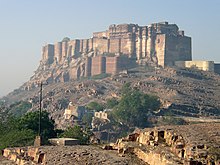Dusky crag martin
It is about 13 cm (5 in) long with a broad body and wings, and a short square tail that has small white patches near the tips of most of its feathers.
The two subspecies are resident breeding birds in South Asia from the Indian subcontinent to southwestern China and the northern parts of Thailand, Vietnam and Laos.
[4] The genus name is derived from the Greek ptuon (πτύον), "a fan", referring to the shape of the opened tail, and Procne (Πρόκνη), a mythological girl who was turned into a swallow.
[8] The nominate subspecies of the dusky crag martin breeds in much of the Indian subcontinent from the base of the Himalayas south to the Nilgiri mountains and east to West Bengal,[13] and P. c. sintaungensis is found in southwestern China, and the northern parts of Thailand, Vietnam and Laos.
The dusky crag martin is largely resident apart from local movements after breeding, but it has bred in Malaysia at least once, and occurred as a vagrant to Sri Lanka and probably Borneo.
Stone buildings such as old hill forts, mosques and tombs are preferred, and other artificial sites include bridges, archways and culverts.
The nest, built by both adults, is an open half-cup made of mud and lined with soft material such as feathers or dry grass.
The martin exploits the area close to the cliff when it hunts, relying on its high manoeuvrability and ability to perform tight turns.
[19] In addition to predation by birds of prey such as the peregrine falcon, this small martin has been recorded in the diet of the greater false vampire bat, Megaderma lyra.
[20] The total population of the dusky crag martin has not been quantified, but it is suspected to be increasing owing to the availability of artificial nest sites.
[1] This martin is locally common in India, Thailand, and southern China,[8][21] and there appear to be range extensions to the northeast into Guangxi,[22] southwards into lowland Laos,[23] and westwards to the hills and plains of Sindh.
[25] Its large range and presumed high numbers mean that the dusky crag martin is not considered to be threatened, and it is classed as Least Concern on the IUCN Red List.
